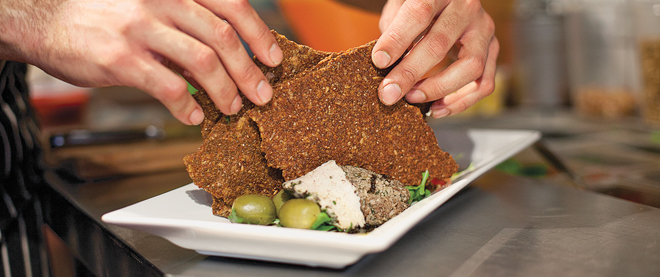Your Chia pet is good for you
The ancient aztec seed that grows on the novelty pet is the newest superfood
Photograph by Jessica Darmanin
Share

“Who knew, 30 years ago, that chia had all these wonderful health properties?” exclaims Joseph Pedott, the entrepreneur who marketed the Chia Pet, the famous terracotta figurine of infomercial fame that’s sold more than 10 million units. “It was the furthest thing from my mind back then. I’d heard something about chia as food for the Aztecs, but I never imagined it was actually true.”
It’s true, and then some. Chia (Salvia hispanica L.) is a seed cultivated since pre-Columbian times in Mexico and Guatemala. “There are four main things to know about chia,” says Edmonton-born Wayne Coates, known as the “father of chia” and professor emeritus at the University of Arizona, where he started studying the seed in 1991. “It’s the highest plant source of omega-3 fatty acids. It’s an antioxidant on par with wild blueberries. It has over 20 per cent protein, which is higher than wheat, and it’s a great source of soluble and insoluble fibre.”
Compared to flaxseed, chia has three times the calcium and half the sodium, says Coates. “I don’t like to run down flax, especially since Canada is the largest maker of flaxseed, but chia is just easier to use and it has no flavour or known allergens. The calories sound high, at 525 per 100 g, but they’re good calories, from chia’s 30 per cent oil, which has the omega-3s we need.” The gluten-free chia seeds absorb up to 10 times their weight in water, which helps make people feel full faster and longer. “When people ask me the difference between the black and white seeds,” notes Coates, author of Chia: Rediscovering a Forgotten Crop of the Aztecs, “I explain that the darker seeds contain more antioxidants, just like darker fruits and vegetables. But the white seeds are less noticeable when they get stuck in your teeth.”
“Chia seeds are one of the hot superfoods inching toward the mainstream, on the brink of being widely accepted,” says Christine Couvelier, a culinary “trendologist” and executive chef in Vancouver. “It’s following on the heels of others, like quinoa and pomegranates. Ten years ago, pomegranates weren’t accessible, but now they’re everywhere.”
Chia got a big push into the limelight last month when it was featured in a segment of The Dr. Oz Show, where it was anointed a “superseed.” To bring things full circle, a Dr. Oz Chia Pet was created by Pedott and his team and presented to Oz on the show. “The whole time we were watering our Chia Pets, we could’ve been eating them!” laughs Los Angeles-based chef Julie Morris, author of Superfood Cuisine: Cooking with Nature’s Most Amazing Foods. “There’s no official list of superfoods, but chia definitely qualifies and it’s the first one I recommend because it’s the easiest to incorporate into your diet. All you have to do is sprinkle two or three tablespoons on cereal or in smoothies, stews, soup or yogourt. And it’s relatively inexpensive, at $7 or $8 a bag.”
Morris worked with Vancouver-based athlete and health advocate Brendan Brazier to create recipes for Brazier’s new book Whole Foods to Thrive, where chia is a featured ingredient in puddings, cereal, energy bars and drinks. “You spend less energy digesting chia and you get a lot of nutrients in return, so I call it a ‘high net-gain food,’ ” says Brazier. “Many people don’t know it, but when chia is mixed with water, it’s a great egg replacer and binding agent.”
Live Organic Food Bar in Toronto has had chia on the menu for five years. “We make a sun-dried tomato chia cracker,” says owner Jennifer Italiano, “and we do a chia pudding and chia lemonade.” Cobs Bread sells nine types of baked goods with chia and has seen a surge of interest lately. “At first,” says Michelle Duck, Cobs’s marketing manager, “we had to learn how to correctly fold the whole seeds into the dough, or else it would become gelatinous quickly, but we perfected it.” Prana, a Montreal-based food company, was among the first to bring chia oil to market last year. “The demand for anything chia is crazy,” says owner Marie-Josée Richer. “It has grown over 10 times in two years.” Prana’s new oil is made from chia grown in Mexico, where the seeds are cold-pressed. Clearly, anyone adhering to the 100-mile diet is out of luck when it comes to chia, which is imported from Bolivia, Equador, Mexico, Guatemala and Australia. “I’ve tried to grow chia in the deserts in Saskatchewan, the mountains of B.C. and on my farm in Ontario,” says Mark Gobuty, a Canadian chia pioneer who first championed it under the brand name Salba in 2007. He now owns Mum’s Original, which sells organic chia and hemp. “We just don’t have the heat units for it to flower here.”
Meanwhile, Joseph Pedott is expanding his business and is working on a chia health bar. As for whether the Dr. Oz Chia will outsell the Barack Obama or Homer Simpson Chias, he says it is unlikely. “Dr. Oz was a one-off.”